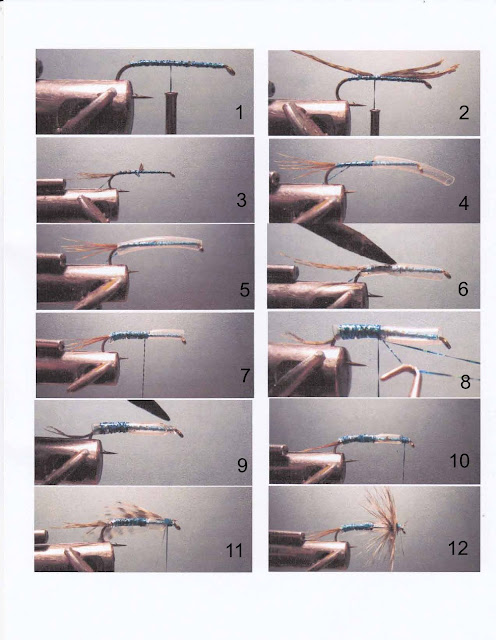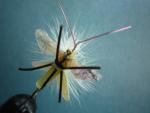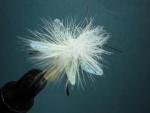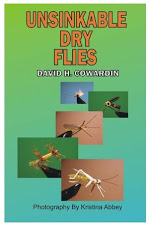



This pattern works extremely well and was developed as an alternative to the purple haze. When I first tied it I wondered if it would work, when it did I wondered why -- Thus Dave's Montana Wonder Bug.
Recipe Montana Wonder Bug
Hook: Any brand 4X long size 6 to 16 with a fine wire, having as wide a gape as possible. (aberdeen hook)
Thread: Purple 6/0 (70 denier) or larger (Metallic Thread if available)
Body: Purple Heat Shrink 1/8 or 3/16 diameter colored with alcohol ink: Note other sizes can be used with smaller hooks. Tan Foam. Don't like heat shrink use purple foam.
Legs: Medium to fine speckled white rubber centipede leg material
Post: White Polypropylene Yarn
Wing: Saddle white dun and (Optional) white web wing or similar
Egg Sack: (Optional) Black Foam
Hook: Any brand 4X long size 6 to 16 with a fine wire, having as wide a gape as possible. (aberdeen hook)
Thread: Purple 6/0 (70 denier) or larger (Metallic Thread if available)
Body: Purple Heat Shrink 1/8 or 3/16 diameter colored with alcohol ink: Note other sizes can be used with smaller hooks. Tan Foam. Don't like heat shrink use purple foam.
Legs: Medium to fine speckled white rubber centipede leg material
Post: White Polypropylene Yarn
Wing: Saddle white dun and (Optional) white web wing or similar
Egg Sack: (Optional) Black Foam
Tail: (Optional) White Goose Biots
1. Cut a single or two twin sections of Heat Shrink as long as the hook shank plus at least a 1/8 inch. Note: Twin sections are used when using smaller Heat Shrink.
2. Cut a section of tan foam approximately the same width as the Heat Shrink.
3. Cover the hook shank with thread.
 4. Attach the heat shrink at the rear of the hook one section at a time using at least three thread wraps. Use heat to pinch the heat shrink to the hook shank.
4. Attach the heat shrink at the rear of the hook one section at a time using at least three thread wraps. Use heat to pinch the heat shrink to the hook shank.
5. Attach the foam at the rear of the hook shank and work the thread up to the eye.
1. Cut a single or two twin sections of Heat Shrink as long as the hook shank plus at least a 1/8 inch. Note: Twin sections are used when using smaller Heat Shrink.
2. Cut a section of tan foam approximately the same width as the Heat Shrink.
3. Cover the hook shank with thread.
 4. Attach the heat shrink at the rear of the hook one section at a time using at least three thread wraps. Use heat to pinch the heat shrink to the hook shank.
4. Attach the heat shrink at the rear of the hook one section at a time using at least three thread wraps. Use heat to pinch the heat shrink to the hook shank.5. Attach the foam at the rear of the hook shank and work the thread up to the eye.
6. Attach the heat shrink and foam at the eye using at least three thread wraps. Use heat to pinch the heat shrink to the hook shank and finish forming the air bubble.
7. Seal the thread at the hook eye with head cement or super glue. Trim off any excess foam and heat shrink.
8. Attach the centipede legs in a crossing pattern between the with tread when attaching the foam and heat shrink.the foam and hook shank. Note: legs can added at the rear and eye anchor point.
9. Cement the legs in place with super glue if you use the crossing pattern.
10. Add the Heat Shrink, optional white web wing or similar, and PP post taking 6-8 wraps around the post with light blue dun or white saddle parachute style. Seal the thread at the hook eye with super glue.
11. Tails (white biots) and black foam egg sack can be added but do not seem to improve the patterns performance.















